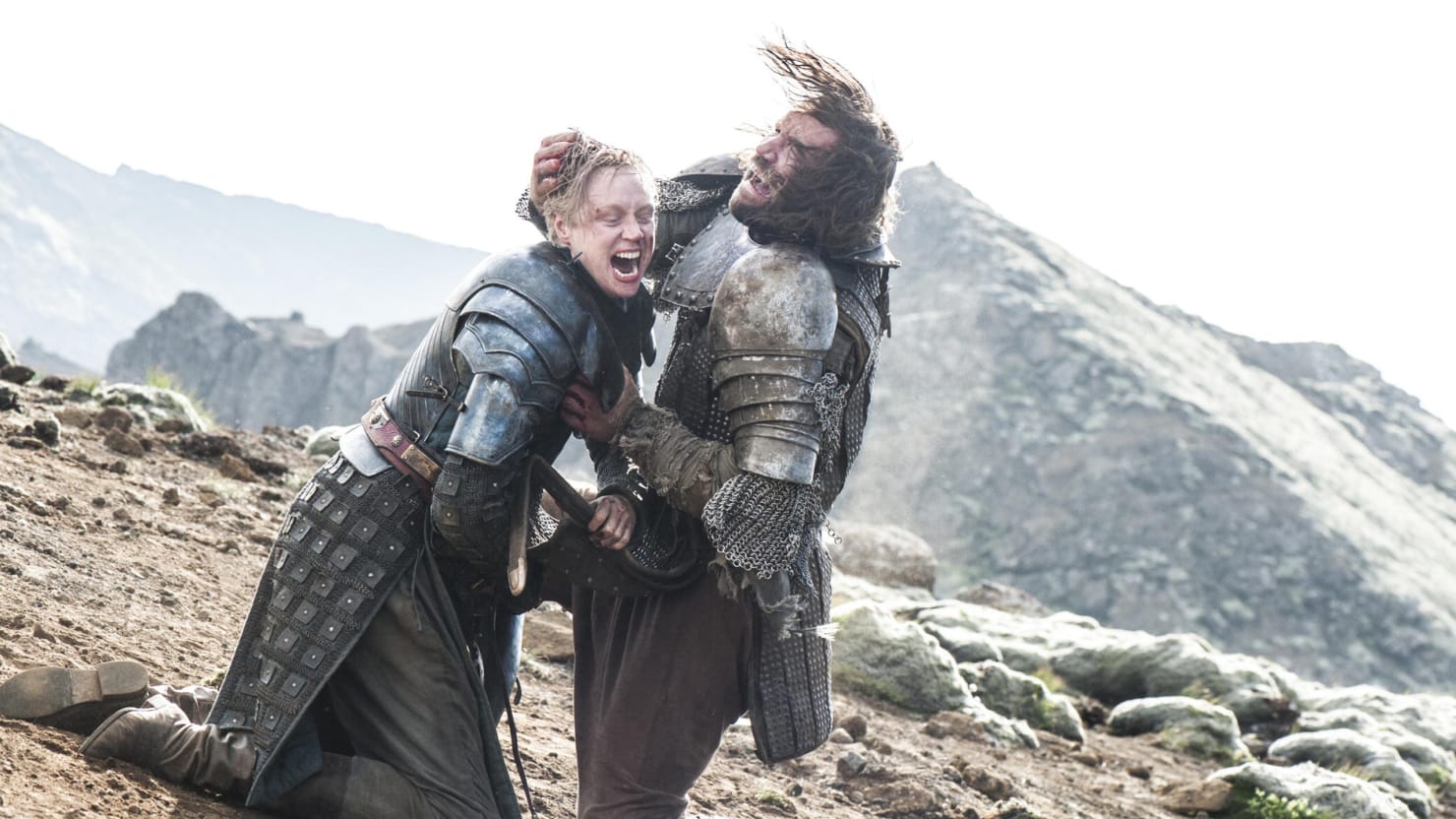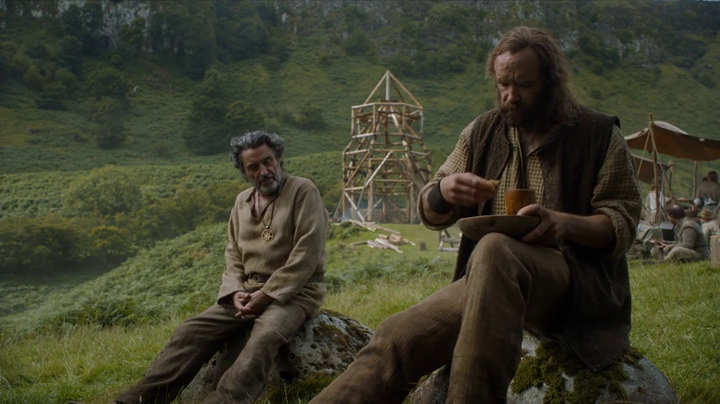Part 4: Religion & Character Growth: An Analysis of Sandor Clegane

Sandor “The Hound” Clegane
George R. R. Martin’s greatest strength as a writer is arguably
his ability to write and develop realistic, multi-dimensional characters with believable
positive and negative traits. It follows that there are rarely any purely good
or evil characters in ASOIAF. Martin has described his character-writing
process as planting a seed and letting the plant grow by watering it. He doesn’t
have a particular character’s story decided upon at any given time, just the
cornerstone of their personality and driving influences. As such, he lets the intrigue
happen naturally based on how he believes certain personalities would interact
with one another, and simply “waters” the storyline to see how his characters
respond. Given this technique, we often see characters develop substantially
and in unique ways over time during ASOIAF compared to other works of fiction.
Specifically, for this project, we will examine what major characters were
influenced by the many religions of the series, and how religion can play both
a positive and negative role in personal development.
The most obvious example of a character arc fuelled by
religious influence in ASOIAF is that of Sandor “The Hound” Clegane. As
significant parts of his story have occurred in the show and have yet to occur
in the novels, we will refer to the show for this section of discussion.
At the beginning of the series, The Hound is presented as a
grizzled, callous warrior with no regard for the well-being of others despite a
hidden sense of personal honour. He and house Clegane, namely his brother
Gregor “The Mountain” Clegane, are fiercely loyal to House Lannister, with his
brother often being referred to as “Tywin Lannister’s Mad Dog”. With a reputation
for brutality, The Hound and The Mountain are feared by many and with good
reason. The audience is told many accounts of the brothers effortlessly slaying
dozens of civilians and innocent people based on orders from Tywin Lannister (who
is often and very interestingly compared to Machiavelli). In fact, it is Gregor
who brutally murders Elia Martell and the young children of Elia and Rhaegar
Targaryen during Robert and Tywin’s sack of King’s Landing during the rebellion,
an action that Oberyn Martell notoriously tried to claim vengeance for in
season 4.
A history of House Clegane and their relationship to House Lannister
The Clegane brothers’ willingness to perform awful deeds has
earned them a less-than-favorable reputation in the Seven Kingdoms and as such
they are feared by most. However, early in the series we see that Gregor and Sandor
are two very different characters and should not be lumped together as one as most of the kingdom insists on doing.
While Gregor enjoys killing, regardless of motive, and is often shown killing
for sport, Sandor only kills when he is instructed to, and is occasionally
defiant if he believes the cause to be unworthy. In short, it can be said that
Sandor possesses a strong, yet suppressed sense of empathy while Gregor certainly
does not. This is likely due to the torture Sandor experienced at the hands of
Gregor during childhood. As punishment for stealing a toy, Gregor held Sandor’s
face against a fire until he was saved, leaving him permanently scarred and
terrified of fire. With reference to Martin’s writing technique, it can be said
that this is Sandor’s cornerstone, and the way he is presented early in the
series are his basic personality traits.

Sandor standing off against his brother Gregor during the dragon-pit parley in season 7
We see Sandor begin to veer from his reputation early in the
series when he takes a liking to the Stark girls, particularly Sansa Stark,
during their stay in King’s Landing. Referring to Sansa as “the little bird”,
he constantly intervenes during Joffrey’s unjust and cruel treatment of her and
her companions. In season 1 episode 10, when Joffrey forces Sansa to look at
her father’s head on a spike, Sandor calls her aside and offers counsel on how
to avoid cruelty from the king despite serving on his kingsguard as Joffrey’s
personal bodyguard. He also supports Sansa’s false reasoning for sparing Ser
Dontos on Joffrey’s name day, calming Joffrey down in the process in season 2
episode 1. Perhaps most significantly, in season 2 episode 5, he saves Sansa
from being raped during the riots against Joffrey in the streets of King’s
Landing. Ultimately, these events alongside the public uprising against Joffrey
cause Sandor to leave King’s Landing in protest, signifying the beginning of
his character arc.
After abandoning his post in King’s Landing, Sandor is captured
by the Brotherhood Without Banners, from whom he eventually escapes with Arya
Stark who despises him for slaying her friend Mycah. During this escape,
Melisandre prophetically tells Sandor “Go in peace, Sandor Clegane. The Lord of
Light isn't done with you yet”. Arya and Sandor spend the next two seasons of
the show travelling together and, as such, influence one another very significantly.
Arya learns valuable skills as a warrior from Sandor, while Sandor is taught to
embrace the sense of empathy that separates him from his psychopathic brother
by Arya. A notable event during Arya and Sandor’s interaction that will be
significant later is when the pair come across a farmer and his daughter who offer them refuge in return for labor during their travels. The farmer’s
crops are not producing enough to sustain a family, so Sandor attacks the farmer,
robs him, and flees, claiming that he will surely die during the winter and
that “dead people don’t need money” in response to Arya’s disapproval.

Sandor Clegane vs. Brienne of Tarth for protective rights over Arya Stark
Ultimately, Arya and Sandor’s partnership is ended by
Brienne of Tarth, who has sworn to the late Catelyn Stark to protect her
family. As such, upon discovering the pair in The Vale, Brienne engages in
one-on-one combat against Sandor for “custody” of Arya and wins, leaving him
begging for death at the bottom of a cliff. At this point in the story, Sandor
is presumed dead by those who saw him last, including Arya who refused to mercy-kill
him. Symbolically, we can view this as the death of the old Sandor Clegane.
The next time we see Sandor is in season 6, episode 7, appropriately
titled The Broken Man. Here we learn
that a nearly-dead Sandor was found and revived by Brother Ray, a former
warrior turned vagrant Septon. Ray brings Sandor to his village, where Sandor
serves as a labourer during the construction of a Sept. Alongside being
literally reborn with help from a Septon, Sandor undergoes significant
spiritual development during his time with Brother Ray and his villagers. When
Ray asks what kept Sandor alive, he responds with “hate”, much to Ray’s dismay.
Ray then suggests that there’s a reason that Sandor survived and that “the gods
aren’t done with [him] yet”, echoing Melisandre’s quote from season 3. Sandor
remarks that he has heard this before, but from a woman of a different faith,
to which Ray responds that he truly doesn’t know which god is real, or whether they’re
all the same, but that he’s certain one of them exists and that he has a plan
for Sandor. Sandor then asks why, if the gods exist, haven’t they punished him
yet to which Ray responds that they have. This suggests that Sandor has
undergone his atonement, or katabasis
(see Part 3), when he accepted death after his fight with Brienne and is now
on a destined path for spiritual retribution.

A recently saved Sandor Clegane conversing with Brother Ray
During his time in the village, Sandor witnesses and begins
to adopt some of Ray’s doctrines and practices. During a speech Ray gives to a
village, he describes assassinating a young boy based on orders and being
haunted by shame regarding this for the rest of his life. As such, he has given
up his life as a warrior and has dedicated his life to religion and altruism by
doing what he can to spread his positive message and be kind to those around
him. This speaks to Sandor, who has shown remorse for his heinous actions
throughout the series. However, in accepting Ray’s religiously-influenced way
of thinking, Sandor does not wish to completely abandon his warrior ways. While
discussing the threat of rogue Brotherhood bandits, Ray states that you don’t
stop a disease (violence) by spreading it, to which Sandor responds that you
also cannot stop a disease by dying. This shows that Sandor has begun to
dislike violence, but still believes it is necessary for survival. When Sandor
finds Ray and the villagers slain by the Brotherhood bandits, he looks to the
half-built Sept then looks to his axe and grabs it as the episode ends. This
ultimately represents the amalgamation of Ray’s character with Sandor’s; Sandor
leaves the village as a new man, indoctrinated by Ray’s teachings while
remaining true to his core values.
Finally, in season 7 we see a very explicit demonstration of
Sandor’s character arc and how it was influenced by morality, empathy, and the
religious teachings of Brother Ray. While travelling north with Thoros of Myr
and Beric Dondarion, the group finds the farmhouse owned by the farmer and his
daughter who housed Sandor and Arya during season 4 as previously discussed. Needing
shelter, the group enters the house and finds the remains of the farmer and his
daughter, who Sandor had left there to die after robbing them as he deemed them
a lost cause. Sandor is visibly shaken by grief regarding this, and ultimately
buries the bodies as a sign of remorse and respect for the dead. This is
something that Sandor would never have done just two seasons ago, having
callously killed dozens of people in the past, but with the influence of
religion and the belief in a greater purpose, he has evolved into a more empathetic,
respectful person. While the story is not yet finished, many fans speculate
that The Hound’s final deed of the story will be to take down his brother,
Gregor, who is one of queen Cersei’s most valuable assets. This deed would be
extremely significant to the overall plot of GoT and ASOIAF and would likely be
the purpose for which Sandor was kept alive according to Melisandre and Ray.

Sandor Clegane burying the bones of the farmer and the girl he left to die earler in the series
Sandor’s character arc pertaining to religion isn’t the only
one in portrayed in the show, but it is certainly the most well defined. While
Sandor doesn’t abandon who he is as a person (like Stannis Baratheon, for
example), he amalgamates his newfound (albeit vaguely defined) faith with his
core values and personality to develop into one of the central heroes of
ASOIAF. This is Martin’s way of showing that religion can play an extremely
positive role in someone’s life without being all-encompassing. With faith
serving as a moral compass instead of a strict set of laws to follow, it can
very effectively craft someone into an empathetic and heroic individual.
Comments
Post a Comment